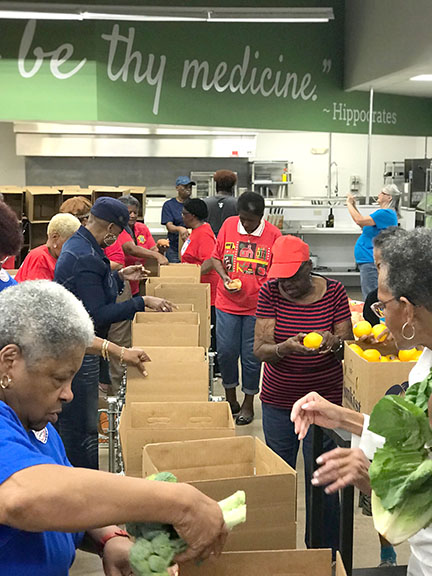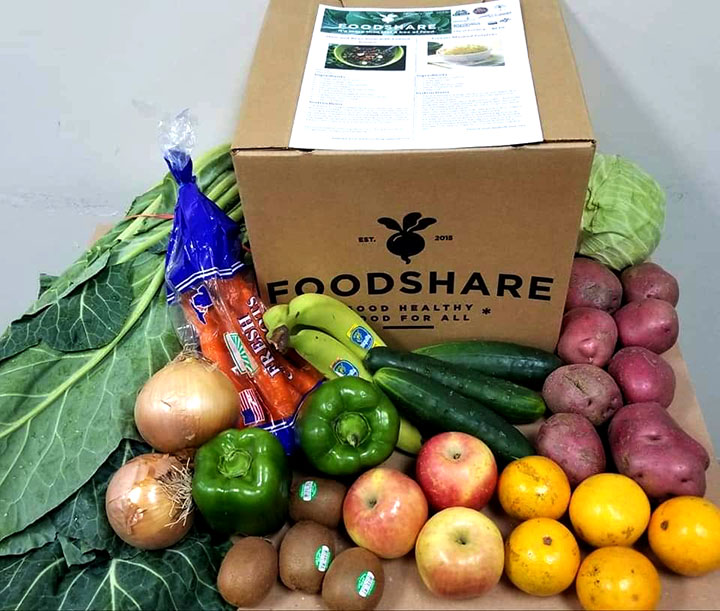Harvest Hope volunteers move produce from fridges to be packed and distributed. (Photo by Sammy Sobich)
The food landscape for Columbia residents living in low-access food areas soon could change.
The city of Columbia is partnering with organizations to bring fresh, local produce to under serviced areas at little to no cost. Such access is significantly lacking, according to a Columbia Food Policy Committee study from 2019.
Fresh fruits and vegetables are more expensive than highly processed foods, and in most cases, more difficult to obtain. It’s more convenient for families to buy cheaper food that’s ready to eat but often less nutritious, fresh food advocates say.
“It’s a lot easier for someone to walk into a supermarket and buy a frozen pizza for $5 to feed their family,” said Omme-Salma Rahemtullah, the committee’s director of advocacy and policy member.
The city isn’t providing food itself. It has just added a food distribution map to its website so residents can see where to go for fresh, affordable food – grocery stores, farmers markets and food pantries.
One location is FoodShare SC, which helps increase food access and affordability and shares the importance of food education across 20 South Carolina counties.
Through bulk-buying programs, FoodShare SC offers fresh food boxes of 15 pounds to 18 pounds worth of produce and a wide variety of fruits and vegetables in each box.
The incentive is for customers to purchase a diverse box of fresh produce in large amounts for a low price. Boxes cost $15, or $5 with some food stamps.
“We see a lot of repeat customers,” Rahemtullah said. “We build relationships where we can, then further build upon each individual’s needs.”
FoodShare SC also has a culinary medicine program based on nutrition science that teaches USC medical students about the evidence-based benefits of food, alongside medication. Good quality food can help prevent and treat chronic diseases such as diabetes as well as restore overall well-being, Rahemtullah said.
Grassroots organizations, such as farmers markets, also are connecting the community to other healthy food options.
The “farm to market” approach is exactly what Neset Hikmet, an engineering professor at the University of South Carolina, wanted to bring to Columbia. Earlier this year, he purchased the basement, ground and 1st floor of 912 Lady St. with plans to restore the historic Vista warehouse.
Hikmet said the goal is to bring customers an “old-fashioned shopping experience.” He said he’s excited about bringing life back to the 100-year-old building and is recruiting mom-and-pop bakers and local farmers and plans to add a café to the 10,000-square-foot space.
Importantly, he said he wants to create a support system and community space for local farmers who don’t have the means, capacity or volume to go wholesale.
Megan Evans, a marketing and communications specialist at Harvest Hope’s emergency food pantry on Shop Road, says that the pantry is not just a food distribution center but also a place for the community to come together.
Harvest Hope provides for the city’s most vulnerable citizens: children, seniors, and rural residents who don’t have easy access to grocery stores. Residents can pick up five-to-six days’ worth of fruit, vegetables, bread, meat and dried goods for free.
Evans says Harvest Hope distributes food during the week at several location but works to pack boxes of donated food seven days a week using volunteers, many of them seniors.
“Most of them are long-time volunteers that love to come for the companionship,” Evans said.
One of Harvest Hope’s biggest projects, BackPack Programs, provides meals and high nutrition, after-school snacks for Midlands children. Every month, more than 10,000 boxes are packed and distributed at schools on Fridays.
The backpacks are filled with enough food for dinner on Friday and breakfast, lunch, dinner and snacks for Saturday and Sunday.
The city is continually updating its map of food distributors. Find the link here.





